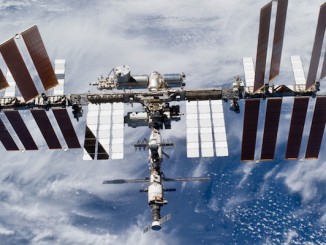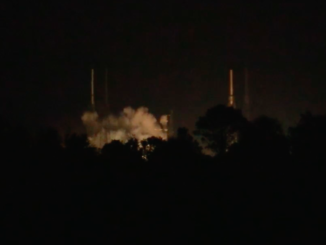
A robotic U.S. military spaceplane surpassed 719 days in orbit Monday, setting a new record for the longest flight of the Air Force’s winged X-37B orbiting experiment platform nearly two years after launching from Florida on a SpaceX Falcon 9 rocket.
Air Force officials have not said when the spacecraft will come back to Earth, or released much detail on the X-37B’s mission. When its mission is complete, it is expected to return to NASA’s Kennedy Space Center in Florida for a landing on the three-mile-long runway originally built for the space shuttle.
The current mission is the fifth flight of the Air Force’s X-37B spaceplane. Boeing has built at least two space-worthy X-37B vehicles, and the aerospace contractor refurbishes the reusable spacecraft inside a modified space shuttle hangar at Kennedy.
The X-37B spaceplane, also called the Orbital Test Vehicle, is about one-fourth the length of NASA’s retired space shuttle orbiters. The X-37B does not carry a crew and has no windows, but it can stay in orbit for years thanks to a deployable solar array to generate electricity.
Developed by Boeing’s Phantom Works division, the X-37B spaceplane can haul experiments and small satellites into orbit, then return equipment to Earth inside its cargo bay. Each spaceship has a wingspan of nearly 15 feet (4.5 meters) and a length of more than 29 feet (8.9 meters). The ship’s wings fit snugly inside the 17-foot-diameter (5-meter) payload shrouds on the Falcon 9 and Atlas 5 rockets.
The X-37B weighs about 11,000 pounds (5 metric tons), according to the Air Force.
The fifth X-37B mission launched Sept. 7, 2017, from launch pad 39A at Kennedy aboard a SpaceX Falcon 9 rocket. The four previous X-37B flights took off on United Launch Alliance Atlas 5 rockets from a nearby pad at Cape Canaveral.

The Falcon 9 rocket deployed the X-37B spacecraft into low Earth orbit, but the Air Force did not publish the orbit’s parameters, keeping with military policy for classified space missions.
Amateur satellite trackers found the X-37B in April 2018 in a circular 221-mile-high (356-kilometer) orbit inclined 54.5 degrees to the equator, a higher orbital inclination than the previous four X-37B missions. The higher inclination allows the spacecraft to fly over more parts of Earth on each trip around the planet.
Since then, the global community of satellite observers has tracked the spaceplane as it changed altitude several times, most recently settling in a more elliptical, or egg-shaped, orbit ranging between 184 miles (297 kilometers) and 209 miles (337 kilometers) above Earth, according to data catalogued by amateur trackers.
“The fifth OTV mission continues to advance the X-37B’s performance and flexibility as a space technology demonstrator and host platform for experimental payloads,” the Air Force said in a press release at the time of launch. “This mission carries small satellite ride shares and will demonstrate greater opportunities for rapid space access and on-orbit testing of emerging space technologies.
“Building upon the fourth mission and previous collaboration with experiment partners, this mission will host the Air Force Research Laboratory Advanced Structurally Embedded Thermal Spreader payload to test experimental electronics and oscillating heat pipe technologies in the long duration space environment,” the Air Force said in a 2017 statement.
The thermal spreader experiment was expected to test three oscillating heat pipes. The new heat pipe technology is lighter and less expensive than components used on most satellites to keep internal avionics temperatures within safe margins.
“The three primary science objectives are to measure the initial on-orbit thermal performance, to measure long duration thermal performance, and to assess any lifetime degradation,” the Air Force Research Laboratory said in a fact sheet.
No other mission objectives were disclosed by the Air Force. Here is a list of the previous X-37B missions.
Orbital Test Vehicle Mission 1
(first flight of Vehicle No. 1)
Launch: April 22, 2010, on Atlas 5 rocket
Landing: Dec. 3 2010, at Vandenberg Air Force Base, California
Duration: 224 days
Orbital Test Vehicle Mission 2
(first flight of Vehicle No. 2)
Launch: March 5, 2011, on Atlas 5 rocket
Landing: June 16, 2012, at Vandenberg Air Force Base, California
Duration: 469 days
Orbital Test Vehicle Mission 3
(second flight of Vehicle No. 1)
Launch: Dec. 11, 2012, on Atlas 5 rocket
Landing: Oct. 17, 2014, at Vandenberg Air Force Base, California
Duration: 675 days
Orbital Test Vehicle Mission 4
(unconfirmed which vehicle)
Launch: May 20, 2015, on Atlas 5 rocket
Landing: May 7, 2017, at Kennedy Space Center, Florida
Duration: 718 days
Orbital Test Vehicle Mission 5
(unconfirmed which vehicle)
Launch: Sept. 7, 2017, on Falcon 9 rocket
Landing: TBD
The Air Force has not announced when the fifth X-37B mission will end. The military announced plans for the first three X-37B landings at Vandenberg Air Force Base, California, ahead of time, but issued no such statements in 2017 ahead of the return of the fourth mission.
The Air Force’s sixth X-37B mission is scheduled for launch some time between April and June 2020. It will lift off from Cape Canaveral on a United Launch Alliance Atlas 5 rocket.
No more than one X-37B spacecraft has been in orbit at one time since the program began.
Email the author.
Follow Stephen Clark on Twitter: @StephenClark1.



